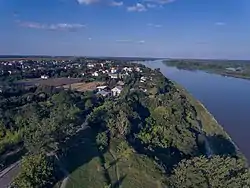Wyszogród
Wyszogród [vɨˈʂɔɡrut] is a town in Poland, in Masovian Voivodeship, in Płock County, by the Vistula River. The population of Wyszogród was 2,793 in 2004.
Wyszogród | |
|---|---|
 Castle hill | |
 Coat of arms | |
 Wyszogród  Wyszogród | |
| Coordinates: 52°23′N 20°12′E | |
| Country | |
| Voivodeship | |
| County | Płock |
| Gmina | Wyszogród |
| Established | 7th century |
| Town rights | 1398 |
| Government | |
| • Mayor | Jan Boszko |
| Area | |
| • Total | 12.96 km2 (5.00 sq mi) |
| Population (2016) | |
| • Total | 2,687 |
| • Density | 210/km2 (540/sq mi) |
| Time zone | UTC+1 (CET) |
| • Summer (DST) | UTC+2 (CEST) |
| Postal code | 09-450 |
| Area code(s) | +48 24 |
| Car plates | WPL |
| Website | http://www.wyszogrod.pl |
History

The settlement dates back to the 7th century, when there was a Slavic pagan temple at the site. In the 11th century Wyszogród became fortified and started to act as a local centre of commerce. In the 12th century it became the seat of local castellany and soon it became one of the seats of the Dukes of Masovia within fragmented Piast-ruled Poland. Relocated on Magdeburg Law in 1398, Wyszogród became one of the most important inland ports and centres of textile production in the area. Brewing and crafts also developed.[1] In the 16th century, King Sigismund II Augustus approved the statutes of the guilds of tailors and furriers, and Sigismund III Vasa issued new privileges for several guilds.[1]
During The Deluge the town was pillaged and burnt by the Swedes. Several subsequent fires destroyed Wyszogród almost completely. During the Swedish invasion of Poland (1701–1706), Polish King Augustus II the Strong stayed in the town in 1704.[1] After the Second Partition of Poland in 1793 it was annexed by Prussia. Prussia initiated German colonization and handed over the old Franciscan church to German Protestant colonists.[2] The town also experienced an influx of Jews.[2] In 1798 the Prussian administration dismantled the old castle of the Piast dynasty.[2] In 1807 the town was reconquered by Poles and included within the short-lived Duchy of Warsaw and after the fall of Napoleon Bonaparte in 1815 it was transferred to the Kingdom of Poland. At the end of 19th century Wyszogród again recovered.
During World War II, the town was heavily damaged during the course of the German invasion of Poland in September 1939. During the German occupation, Poles and Jews were brutalized in the town and conscripted for forced labor. In March 1941, around 120 Poles were expelled from the town, temporarily deported to a camp in Działdowo, where they were stripped of money and valuables, and afterwards deported to the General Government, while their houses were handed over to German colonists as part of the Lebensraum policy.[3] Beginning in March 1941, Jews were deported to other ghettos and then on to Treblinka were they were murdered in October 1941 and to Auschwitz, where most were murdered in November 1942. During these deportations and the time spent in other ghettos, they suffered unimaginable horrors along with starvation and disease. These experiences of the Holocaust resulted in the deaths of all but 250 of Wyszogrod's 2700 Jews.[4]
There were several Polish underground resistance groups operating both within the city and in the forests nearby. The town was rebuilt after the war, though its population did not recover to pre-war levels.
In 1997–1999 a bridge was built over the Vistula River, which was the longest bridge in Poland until the opening of the Solidarity Bridge in Płock in 2007.
Attractions
- The Holy Trinity Church (1773–1786)
- Remnants of the Franciscan abbey
- St. Mary of Angels Church (1408)
- Monastery (1684)
- Old Town market (18th and 19th centuries)
References
- Słownik geograficzny Królestwa Polskiego i innych krajów słowiańskich, Tom XIV (in Polish). Warszawa. 1895. p. 150.
- Słownik geograficzny Królestwa Polskiego i innych krajów słowiańskich, Tom XIV, p. 151
- Wardzyńska, Maria (2017). Wysiedlenia ludności polskiej z okupowanych ziem polskich włączonych do III Rzeszy w latach 1939-1945 (in Polish). Warszawa: IPN. pp. 406–408. ISBN 978-83-8098-174-4.
- Megargee, Geoffrey (2012). Encyclopedia of Camps and Ghettos. Bloomington, Indiana: University of Indiana Press. p. Volume II 28–30. ISBN 978-0-253-35599-7.
External links
- Official town webpage
- Wyszogród at www.jewishgen.org
- Jewish Community in Wyszogród on Virtual Shtetl
| Wikimedia Commons has media related to Wyszogród. |